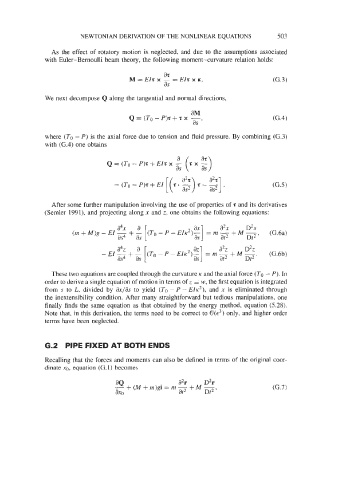Page 533 - Fluid-Structure Interactions Slender Structure and Axial Flow (Volume 1)
P. 533
NEWTONIAN DERIVATION OF THE NONLINEAR EQUATIONS 503
As the effect of rotatory motion is neglected, and due to the assumptions associated
with Euler-Bernoulli beam theory, the following moment-curvature relation holds:
at
M=EIrx --EEltx~. (G.3)
as
We next decompose Q along the tangential and normal directions,
where (To - P) is the axial force due to tension and fluid pressure. By combining (G.3)
with (G.4) one obtains
Q = (To - P)t + EZt x
= (To - P)t + EZ [ (t . $) t - $1 .
After some further manipulation involving the use of properties oft and its derivatives
(Semler 1991), and projecting along x and z, one obtains the following equations:
(G.6a)
D2z
a2Z
(To - P - EZK )- = m - +M -. (G.6b)
as at2 Dt2
These two equations are coupled through the curvature K and the axial force (To - P). In
order to derive a single equation of motion in terms of z = w, the first equation is integrated
from s to L, divided by &/as to yield (To ~ P - EIK~), and x is eliminated through
the inextensibility condition. After many straightforward but tedious manipulations, one
finally finds the same equation as that obtained by the energy method, equation (5.28).
Note that, in this derivation, the terms need to be correct to 0(e3) only, and higher order
terms have been neglected.
6.2 PIPE FIXED AT BOTH ENDS
Recalling that the forces and moments can also be defined in terms of the original coor-
dinate XO, equation (G.l) becomes
aQ a2 r D2r
+
+
- (M + m)gi = m - M -, (G.7)
axo at2 Dt2

